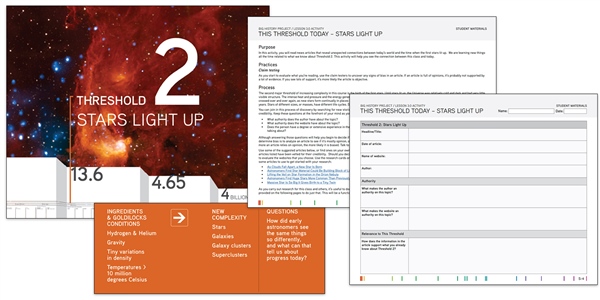By Hayden Brown, OER Project Teacher
Perth, Australia
Note from the OER Project team: As the school year kicks off in Australia, we’re publishing a couple of Australia-centric blogs to help our Aussie teachers hit the ground running. However, this blog is relevant to teachers across the globe in providing tips for how to bring Indigenous and local histories into the classroom.
Too often, the narrative of Aboriginal peoples is missing from Australian history courses. Whether through Big History, or another history class, it is important that our students learn this narrative as an integral part of our collective Australian history—not as a tacked-on lesson at the end of the year. For that reason, I rarely teach standalone lessons that focus only on Aboriginal peoples’ history. Rather, because this history is often intertwined with traditional perspectives of history and science, I try to highlight Aboriginal peoples’ understandings of various topics as we cover them. While I am far from an expert, these are three of my favorite BHP activities, which—with slight revision—include a focus on Aboriginal peoples’ knowledge to enhance my students’ Big History learning.

1.2 Introduction to Origin Stories: I always use this activity as an early intersection between Big History and Aboriginal peoples’ knowledge. To begin, I introduce an Aboriginal story through a guest speaker from the local traditional owners of the land I am teaching on. In 2020, I was able to share the story of the “Carers of Everything,” which is an especially important origin story for the Noongar people.
The rest of the lesson follows the standard format—students read the origin story collection and fill out the table—but, by beginning with an Aboriginal people’s oral tradition, students get an inspirational firsthand introduction to the power of origin stories. This activity is a powerful way to ground your Big History narrative and value the traditional owners of the land that you are teaching and learning on.

3.0 This Threshold Today – Stars Light Up: In this activity, I was looking to make the link between modern astronomy and Aboriginal peoples' culture. Australian Aboriginal people have many origin stories with connections to the night sky, and are often referred to as the first astronomers. When teaching in Broome, I was lucky enough to be able to organize an excursion for my BHP students to do some stargazing. The event was jointly hosted by local astronomer Greg Quicke (who has subsequently become a celebrity with several TV appearances) and a local Yawuru elder. The night was not only an awesome showcase of Threshold 2 today but also a great way for me and my students to see Yawaru culture as current and living.

6.3 Hunter-Gatherer Menu: This is a no-brainer. Aboriginal peoples of this continent are the world’s oldest continuous culture, with a sustainable land management history that exceeds 50,000 years. I always include this lesson as a strong link to First Nation knowledge and environmental practices.
Teaching these perspectives in your Big History class can help you and your students maintain the BHP narrative while also highlighting the diversity and richness of Aboriginal knowledge. To be effective, the role of the teacher in the classroom has to shift from the center of knowledge to lead learner (you can read more about teacher as lead learner in this blog post). Embedding Aboriginal and Torres Strait Islander peoples’ perspectives will enhance the educational experiences of non-Indigenous students as well. It is important for us to acknowledge and respect each other’s perspectives, our ways of seeing the world, and how all of this fits into our shared collective story.
If you’re ready to explore more connections between Aboriginal and Torres Strait Islander people’s perspectives and Big History, you can join Hayden and other teachers from around the world in the OER Project Community.
About the author: Hayden Brown has been teaching the Big History Project course to year 7 and 8 students in Western Australia since 2015, first at a school in Broome, and more recently in Perth. In his BHP classrooms, he brings to life his belief in the importance of Aboriginal peoples; perspective by incorporating one exploration of their perspective or knowledge for each of the Big History thresholds.
 For full access to all OER Project resources AND our amazing teacher community,
For full access to all OER Project resources AND our amazing teacher community, 
